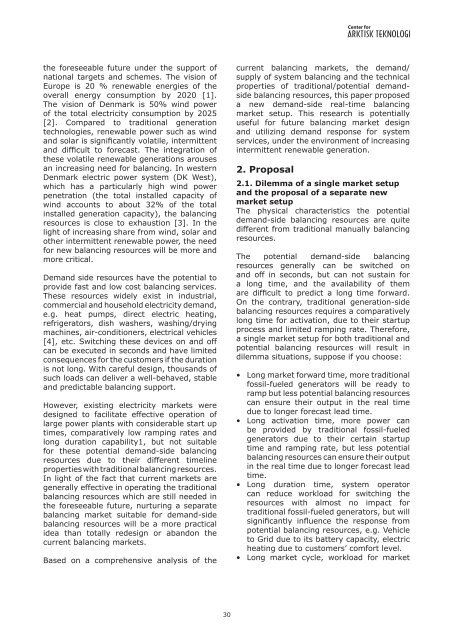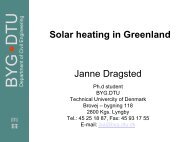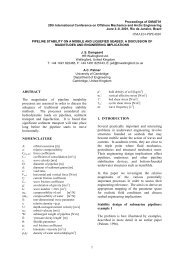Energiforsyning i Arktis – hvilken vej vælger Grønland? - Artek ...
Energiforsyning i Arktis – hvilken vej vælger Grønland? - Artek ...
Energiforsyning i Arktis – hvilken vej vælger Grønland? - Artek ...
You also want an ePaper? Increase the reach of your titles
YUMPU automatically turns print PDFs into web optimized ePapers that Google loves.
the foreseeable future under the support of<br />
national targets and schemes The vision of<br />
Europe is 20 % renewable energies of the<br />
overall energy consumption by 2020 [1]<br />
The vision of Denmark is 50% wind power<br />
of the total electricity consumption by 2025<br />
[2] Compared to traditional generation<br />
technologies, renewable power such as wind<br />
and solar is significantly volatile, intermittent<br />
and difficult to forecast The integration of<br />
these volatile renewable generations arouses<br />
an increasing need for balancing In western<br />
Denmark electric power system (DK West),<br />
which has a particularly high wind power<br />
penetration (the total installed capacity of<br />
wind accounts to about 32% of the total<br />
installed generation capacity), the balancing<br />
resources is close to exhaustion [3] In the<br />
light of increasing share from wind, solar and<br />
other intermittent renewable power, the need<br />
for new balancing resources will be more and<br />
more critical<br />
Demand side resources have the potential to<br />
provide fast and low cost balancing services<br />
These resources widely exist in industrial,<br />
commercial and household electricity demand,<br />
e g heat pumps, direct electric heating,<br />
refrigerators, dish washers, washing/drying<br />
machines, air-conditioners, electrical vehicles<br />
[4], etc Switching these devices on and off<br />
can be executed in seconds and have limited<br />
consequences for the customers if the duration<br />
is not long With careful design, thousands of<br />
such loads can deliver a well-behaved, stable<br />
and predictable balancing support<br />
However, existing electricity markets were<br />
designed to facilitate effective operation of<br />
large power plants with considerable start up<br />
times, comparatively low ramping rates and<br />
long duration capability1, but not suitable<br />
for these potential demand-side balancing<br />
resources due to their different timeline<br />
properties with traditional balancing resources<br />
In light of the fact that current markets are<br />
generally effective in operating the traditional<br />
balancing resources which are still needed in<br />
the foreseeable future, nurturing a separate<br />
balancing market suitable for demand-side<br />
balancing resources will be a more practical<br />
idea than totally redesign or abandon the<br />
current balancing markets<br />
Based on a comprehensive analysis of the<br />
30<br />
current balancing markets, the demand/<br />
supply of system balancing and the technical<br />
properties of traditional/potential demandside<br />
balancing resources, this paper proposed<br />
a new demand-side real-time balancing<br />
market setup This research is potentially<br />
useful for future balancing market design<br />
and utilizing demand response for system<br />
services, under the environment of increasing<br />
intermittent renewable generation<br />
2. Proposal<br />
2.1. Dilemma of a single market setup<br />
and the proposal of a separate new<br />
market setup<br />
The physical characteristics the potential<br />
demand-side balancing resources are quite<br />
different from traditional manually balancing<br />
resources<br />
The potential demand-side balancing<br />
resources generally can be switched on<br />
and off in seconds, but can not sustain for<br />
a long time, and the availability of them<br />
are difficult to predict a long time forward<br />
On the contrary, traditional generation-side<br />
balancing resources requires a comparatively<br />
long time for activation, due to their startup<br />
process and limited ramping rate Therefore,<br />
a single market setup for both traditional and<br />
potential balancing resources will result in<br />
dilemma situations, suppose if you choose:<br />
• Long market forward time, more traditional<br />
fossil-fueled generators will be ready to<br />
ramp but less potential balancing resources<br />
can ensure their output in the real time<br />
due to longer forecast lead time<br />
• Long activation time, more power can<br />
be provided by traditional fossil-fueled<br />
generators due to their certain startup<br />
time and ramping rate, but less potential<br />
balancing resources can ensure their output<br />
in the real time due to longer forecast lead<br />
time<br />
• Long duration time, system operator<br />
can reduce workload for switching the<br />
resources with almost no impact for<br />
traditional fossil-fueled generators, but will<br />
significantly influence the response from<br />
potential balancing resources, e g Vehicle<br />
to Grid due to its battery capacity, electric<br />
heating due to customers’ comfort level<br />
• Long market cycle, workload for market





